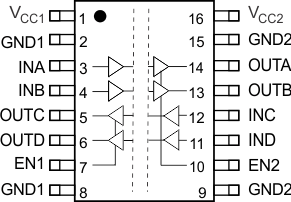-
ISO7142CC-Q1 4242-VPK Small-Footprint and Low-Power Quad Channel Digital Isolator
- 1 Features
- 2 Applications
- 3 Description
- 4 Revision History
- 5 Pin Configuration and Functions
-
6 Specifications
- 6.1 Absolute Maximum Ratings
- 6.2 ESD Ratings
- 6.3 Recommended Operating Conditions
- 6.4 Thermal Information
- 6.5 Electrical Characteristics—5-V Supply
- 6.6 Supply Current Characteristics—5-V Supply
- 6.7 Electrical Characteristics—3.3-V Supply
- 6.8 Supply Current Characteristics—3.3-V Supply
- 6.9 Electrical Characteristics—2.7-V Supply
- 6.10 Supply Current Characteristics—2.7-V Supply
- 6.11 Power Dissipation Characteristics
- 6.12 Switching Characteristics—5-V Supply
- 6.13 Switching Characteristics—3.3-V Supply
- 6.14 Switching Characteristics—2.7-V Supply
- 6.15 Typical Characteristics
- 7 Parameter Measurement Information
- 8 Detailed Description
- 9 Application and Implementation
- 10Power Supply Recommendations
- 11Layout
- 12Device and Documentation Support
- 13Mechanical, Packaging, and Orderable Information
- IMPORTANT NOTICE
Package Options
Mechanical Data (Package|Pins)
- DBQ|16
Thermal pad, mechanical data (Package|Pins)
Orderable Information
ISO7142CC-Q1 4242-VPK Small-Footprint and Low-Power Quad Channel Digital Isolator
1 Features
- Qualified for Automotive Applications
- AEC-Q100 Qualified With the Following Results:
- Device Temperature Grade 1: –40°C to +125°C Ambient Operating Temperature Range
- Device HBM Classification Level 3A
- Device CDM Classification Level C6
- Maximum Signaling Rate: 50 Mbps (with 5-V Supplies)
- Robust Design With Integrated Noise Filter
- Low-Power Consumption, Typical ICC per Channel (With 3.3-V Supplies):
- 1.3 mA at 1 Mbps, 2.5 mA at 25 Mbps
- 50 kV/µs Transient Immunity, Typical
- Long Life with SiO2 Isolation Barrier
- Operates From 2.7-V, 3.3-V and 5-V Supply
- 2.7-V to 5.5-V Level Translation
- Small QSOP-16 Package
- Safety and Regulatory Approvals
- 2500-VRMS Isolation for 1 Minute per UL 1577
- 4242-VPK Isolation per DIN V VDE V 0884-10 (VDE V 0884-10):2006-12
- CSA Component Acceptance Notice 5A, IEC 60950-1 and IEC 61010-1 End Equipment Standards
- Planned CQC Certification per GB4943.1-2011
2 Applications
- General Purpose Isolation
- Industrial Automation
- Motor Control
- Solar Inverters
3 Description
The ISO7142CC-Q1 device provides galvanic isolation up to 2500 VRMS for 1 minute per UL 1577 and 4242-VPK per VDE V 0884-10. The
ISO7142CC-Q1 is a quad-channel isolator with two forward and two reverse-direction channels. This device is capable of maximum data rate of 50 Mbps with 5-V supplies and 40 Mbps with 3.3-V or 2.7-V supplies. The ISO7142CC-Q1 device has integrated filters on the inputs to support noise-prone applications.
Each isolation channel has a logic input and output buffer separated by a silicon dioxide (SiO2) insulation barrier. Used in conjunction with isolated power supplies, this device prevents noise currents on a data bus or other circuits from entering the local ground and interfering with or damaging sensitive circuitry. This device has TTL input thresholds and can operate from 2.7-V, 3.3-V, and 5-V supplies.
Device Information(1)
| PART NUMBER | PACKAGE | BODY SIZE (NOM) |
|---|---|---|
| ISO7142CC-Q1 | SSOP (16) | 4.90 mm × 3.90 mm |
- For all available packages, see the orderable addendum at the end of the data sheet.
Simplified Schematic

4 Revision History
| DATE | REVISION | NOTES |
|---|---|---|
| December 2015 | * | Initial release. |
5 Pin Configuration and Functions

Pin Functions
| PIN | I/O | DESCRIPTION | |
|---|---|---|---|
| NAME | NO. | ||
| EN1 | 7 | I | Output enable 1. Output pins on side 1 are enabled when EN1 is high or open and in high-impedance state when EN1 is low. |
| EN2 | 10 | I | Output enable 2. Output pins on side 2 are enabled when EN2 is high or open and in high-impedance state when EN2 is low. |
| GND1 | 2 | — | Ground connection for VCC1 |
| 8 | |||
| GND2 | 9 | — | Ground connection for VCC2 |
| 15 | |||
| INA | 3 | I | Input, channel A |
| INB | 4 | I | Input, channel B |
| INC | 12 | I | Input, channel C |
| IND | 11 | I | Input, channel D |
| OUTA | 14 | O | Output, channel A |
| OUTB | 13 | O | Output, channel B |
| OUTC | 5 | O | Output, channel C |
| OUTD | 6 | O | Output, channel D |
| VCC1 | 1 | — | Power supply, VCC1 |
| VCC2 | 16 | — | Power supply, VCC2 |